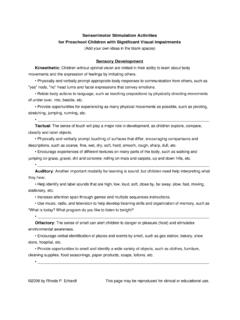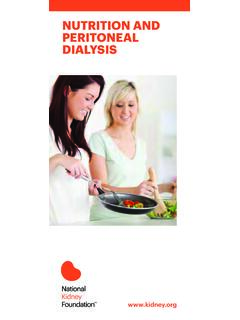Transcription of EVERYTHING YOU NEED TO KNOW TO START FERMENTING …
1 FermentingtheClublatest Probiotic & Gut Health news Lacto Fermentation Tips And TricksNOURISHED ESSENTIALSP rimerfermentingTh e Lacto Fermentation GuideEVERYTHING YOU NEED TO KNOW TO START FERMENTING TODAY COPYRIGHT 2016 ALL RIGHTS guide was written exclusively for the members of the Nourished Essentials FERMENTING Club. Let s Explorefermenting fundamentalsAbout FermentingCONTENTS name surname Copyright 2014 LET FOOD BE THY MEDICINE AND MEDICINE BE THY FOOD. -HIPPOCRATESW ords fromNourishedEssentialsWhether you are a seasoned fermenter or just starting your fi rst ferment, we wanted to prepare a guide to help you through the FERMENTING line of products explores ways to incorporate more traditional cooking methods and techniques into our modern diet.
2 The Easy Fermenter was invented so fermented foods would be easier to is beginning to discover the importance of probiotics, and the eff ect a healthy gut has on our overall well being. By eating probiotic rich foods we are naturally introducing into our diet a wide variety of naturally-occurring micro organisms that many cultures have been consuming for Enjoy!GAVIN [ 5 ]NOURISHED ESSENTIALS COPYRIGHT 2016 What is FERMENTING and how does it work?Fermentation is the method of preserving food by using the good bacteria (probiotics) found naturally on the surface of fruits and vegetables. These bacteria convert the sugars in produce into lactic acid, a natural preservative. If you listen to the food ads, you may think that preservatives are bad, but in the case of lactic acid and those good bacteria that make it, not only is your food preserved, but the nutrition content is increased.
3 How does it work? It is really quite interesting. The fact is, most bad bacteria hate lactic acid or any acid for that matter; they can t stand to be around it. As with many traits we see in nature, these good bacteria have developed this mechanism to keep all of the yummy sugars found in the fruits and veggies to themselves by producing a byproduct that other bacteria can t stand and steer clear of. Keeping these bad bacteria away gives them time to enjoy their tasty meal in peace, but we can benefi t from this as , under normal circumstances, the bacteria would continue to eat the fruit or veggie until there is little to nothing left, but in a controlled environment, such as that created in the human-aided FERMENTING processes, which we will discuss a little later, we can harness this amazing circle of life process to preserve and add amazing fl avor to our t be concerned about the lact- in lactic acid.
4 Lactic acid is not the same thing as lactose, found in milk, which some may be sensitive to or restricted from consuming due to dietary choices; rather the lact- in lactic refers to the bacteria s favorite type of sugar, lactose, which is found in milk. The bacteria are, therefore, called Lactobacillus. L. Acidophilus, a probiotic you are undoubtedly familiar with, is in this family, among many others.[ 6 ]NOURISHED ESSENTIALS COPYRIGHT 2016 What are the benefi tsof FERMENTING food?The benefi ts are defi nitely something to get excited about. Before we talk about health, let s put ourselves in the shoes of our distant ancestors and consider for a moment how excited those who fi rst discovered this process must have been to fi nd a way (long, long before the existence of refrigeration) to preserve the bountiful crops of the harvest and enjoy them throughout the winter when the alternative might have otherwise been near they didn t even know about all of the health benefi ts yet.
5 They knew that fermentation allowed them to keep their children s bellies full, giving them energy [ 7 ]NOURISHED ESSENTIALS COPYRIGHT 2016and vitality to tackle their days and live their lives. So, what are the great health benefi ts of fermented foods? you may ask. I thought foods started losing nutrition the moment they were harvested and in the case of fermentation, I am taking even longer to consume it. Is there really any nutrition left at that point? If you are new to fermentation and asking these questions, you are an informed individual and you may be in for a great shock. Fermented foods don t just retain their nutrition; the nutritional benefi ts actually increase dramatically from the process. The vitamin and enzyme levels go up dramatically.
6 I think we all know that probiotics (good bacteria) are found naturally in our gut and that when we consume more of them, the positive eff ects on digestion and our overall health are amazing. Digestion is how you absorb nutrients. Your life depends on it. If you have digestive issues, you are not absorbing nutrients as you should and you could be retaining toxins in your intestine walls that your body, with the aid of good bacteria, should be able to remove. During the fermentation process these bacteria are multiplying in a controlled environment so you are getting many billions more of them than you would have if you had just eaten that cucumber or cabbage , studies (which can be located by visiting the website for the US National Library of Medicine) have shown that the bacteria found in fermented foods may have an anti-carcinogenic eff ect in the gut, thus potentially preventing things like colon cancer, a very aggressive and often deadly byproduct of the bacteria involved in the fermentation process is wait for it B12, among other B vitamins.
7 B12 is normally found in meat and defi ciency can cause serious mood related issues (among other things), which makes fermented [ 8 ]NOURISHED ESSENTIALS COPYRIGHT 2016foods a must for those living a vegetarian, vegan, or very low-meat lifestyle. If you already eat fermented foods, you may have noticed the mood boost you get almost immediately from consuming them or maybe that is just because they taste great. Either way, the B boost that can be achieved by consuming fermented foods is addition to the nutrients found naturally in the food to be fermented, fermented foods are also rich in vitamins D and K2, which help with calcium absorption, for stronger teeth and bones and reduced infl ammation as well as providing vital support to many other processes and systems within our bodies.
8 And this is just scratching the surface. This could be a whole book should be noted that all fermented products are not the same. Some fermented foods are made with a very diff erent process-high heat, vinegar, and other methods that destroy the benefi cial bacteria. These foods do not have the aforementioned benefi ts. If you got a little excited when you learned about all of the benefi ts of eating fermented foods, then you are going to love the rest of this book because we are going to talk about how easy it is to make these foods yourself. All you need is the know-how ( ) and a little curiosity ( ) and the right tools --- We re getting to that. Let s get started.[ 9 ]NOURISHED ESSENTIALS COPYRIGHT 2016 Getting Startedwith fermentingLet s START with a checklist.
9 Most of these items you probably already have in your kitchen or they are very inexpensive to buy. You will want to have: Something that chops like a slicer, knife, or food processor. A mallet or other blunt instrument. If your meat tenderizer has 2 sides, you can use the smooth side. This is not required for all fermented foods, but for many of the most common it is necessary so you will want to have it on hand. A large, break-resistant container that can take a bit of a beating as you pound your veggies. Unrefi ned sea salt or pickling salt. Filtered water. Mason jar. A weight to keep your produce submerged (If you do not use a weight there are other options for keeping your veggies under the brine). Easy Fermenter OF SALTFor FERMENTING , there are three basic kinds of salt: PICKLING SALTSEA SALTKOSHER SALTEach salt has diff erent properties and will give a slightly diff erent taste, so it is important to consider your goals and preferences and choose the right salt for the [ 10 ]NOURISHED ESSENTIALS COPYRIGHT 2016right SALT (OR CANNING SALT) is sodium chloride, so it is the most similar (but not the same) as your typical table salt.
10 While this is the more traditional choice and least expensive, it should be noted that because it is sodium-based, those who are salt-sensitive or experience bloating or high blood pressure would not benefi t from adding this amount of sodium to their diets. SEA SALT is a type of salt that contains not only sodium, but also chloride, sulfate, magnesium, calcium, and potassium in varying quantities according to sourcing. These are all minerals our bodies need. Because it is more balanced in composition, it is a much healthier choice, but will cost more. The most premium and benefi cial of sea salts is Himalayan sea salt, which contains an even more diverse array of minerals our bodies SALT is also an option for FERMENTING . Kosher salt, while very similar to table salt, has larger grains and is free of the additive iodine found in table salts, which can hinder the FERMENTING process.


